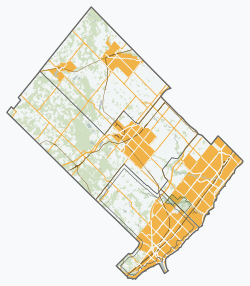
Lucy Maud Montgomery, published as L. M. Montgomery, was a Canadian author best known for a collection of novels, essays, short stories, and poetry beginning in 1908 with Anne of Green Gables. She published 20 novels as well as 530 short stories, 500 poems, and 30 essays. Anne of Green Gables was an immediate success; the title character, orphan Anne Shirley, made Montgomery famous in her lifetime and gave her an international following. Most of the novels were set in Prince Edward Island, and those locations within Canada's smallest province became a literary landmark and popular tourist site – namely Green Gables farm, the genesis of Prince Edward Island National Park. She was made an officer of the Order of the British Empire in 1935.

Georgetown is a large unincorporated community in the town of Halton Hills, Ontario, Canada, in the Regional Municipality of Halton. The town includes several small villages or settlements such as Norval, Limehouse, Stewarttown and Glen Williams near Georgetown and another large population centre, Acton. In 2016, the population of Georgetown was 42,123. It sits on the banks of the Credit River, approximately 40 km west of Toronto, and is part of the Greater Toronto Area. Georgetown was named after entrepreneur George Kennedy who settled in the area in 1821 and built several mills and other businesses.

Halton Hills is a town in the Regional Municipality of Halton, located in the northwestern end of the Greater Toronto Area, Ontario, Canada with a population of 61,161 (2016).

Erin is a town in Wellington County, approximately 80 kilometres (50 mi) northwest of Toronto, Ontario, Canada. Erin is bordered by the Town of Caledon, Ontario to the east, the Town of Halton Hills to the south, the Township of Guelph/Eramosa to the west and the Township of East Garafraxa to the north.

Acton is a community located in the town of Halton Hills, in Halton Region, Ontario, Canada. At the northern end of the Region, it is on the outer edge of the Greater Toronto Area and is one of two of the primary population centres of the Town; the other is Georgetown. From 1842 until 1986, the town was a major centre for the tanning and leather goods industry. In the early years, it was often referred to as "Leathertown".

Swansea is a neighbourhood in the city of Toronto, Ontario, Canada, bounded on the west by the Humber River, on the north by Bloor Street, on the east by High Park and on the south by Lake Ontario. The neighbourhood was originally a separate municipality, the Village of Swansea, which was annexed by the City of Toronto in 1967.

Green Gables Heritage Place is a 19th century farm and literary landmark in Cavendish, Prince Edward Island, Canada. Green Gables served as the setting for the Anne of Green Gables novels by Lucy Maud Montgomery. Green Gables is recognized as a Federal Historic Building by the government of Canada and is situated on the L.M. Montgomery's Cavendish National Historic Site of Canada. The National Historic Site itself is situated on Prince Edward Island National Park.

Glen Williams is a hamlet in Halton Hills, Halton Regional Municipality, Ontario, Canada. It has a population of about 2700 people and its closest neighbours are Georgetown and Terra Cotta.
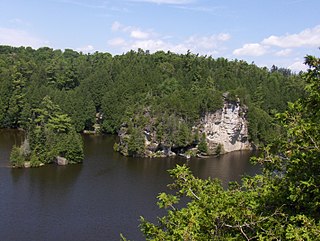
Guelph/Eramosa is a township located in Wellington County, in midwestern Ontario, Canada. It partly encircles the city of Guelph, surrounding it in a continuous arc from approximately northeast to south-southwest of the city. It is part of the Guelph census metropolitan area.

The CN Halton Subdivision is a major railway line in Southern Ontario, Canada. It is owned and operated by the Canadian National Railway (CN).
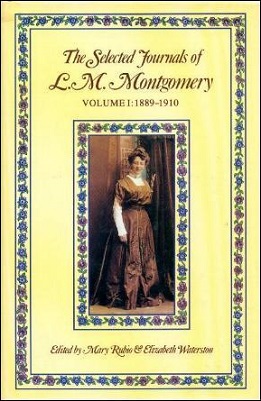
The Selected Journals of L. M. Montgomery, Vol. I–V, are the personal journals of famed Canadian author, Lucy Maud Montgomery (1874–1942).
James McNab was the first settler in Norval, Ontario, originally called "McNab's Mills"

Winston Churchill Boulevard is a long north-south roadway that predominantly forms the western boundary of Peel Region with the eastern boundaries of Halton Region and Wellington County, in Ontario, Canada. The road begins at Lakeshore Road in the south at the boundaries of the City of Mississauga the Town of Oakville, and ends in Caledon at East Garafraxa-Caledon Townline. The road is named in honour of British Prime Minister Sir Winston Churchill.
Esquesing Township was a municipality within the historic Halton County in Ontario, Canada. It is today a geographic township in the town of Halton Hills in the Regional Municipality of Halton.
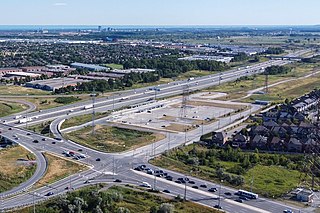
Winston Churchill is a bus station in the community of Erin Mills in western Mississauga, Ontario, Canada. It is located northwest of the Winston Churchill Boulevard / Highway 403 interchange and is the western terminus of the Mississauga Transitway.

Erin Mills is a bus station in the community of Erin Mills in western Mississauga, Ontario, Canada. It is located northwest of the Erin Mills Parkway/Highway 403 interchange and is a stop on the Mississauga Transitway.

Burnhamthorpe Road is a major arterial road in the cities of Toronto and Mississauga, Ontario; beginning at Dundas Street, near Islington Avenue, running west and becoming a rural road in the Town of Oakville, where it terminates at Tremaine Road, where it changes name.
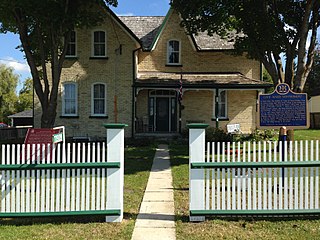
The Leaskdale Manse, located in Uxbridge, Ontario, was the home of Lucy Maud Montgomery, author of the Anne of Green Gables series, and her husband Reverend Ewan Macdonald from 1911 to 1926. Montgomery wrote 11 of the 22 works published in her lifetime in the manse, as well as a series of journals that were published posthumously. The manse, constructed in 1886, was designated a National Historic Site of Canada in 1994 and is now a historic house museum.

